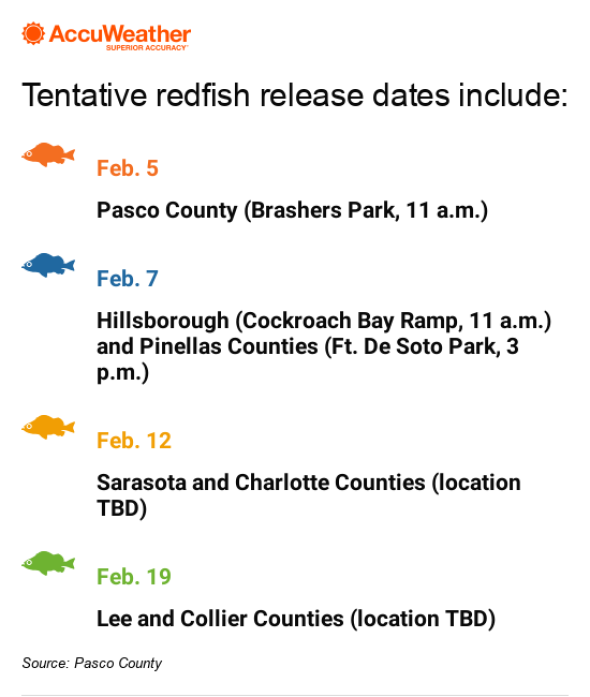10,000 redfish to be released in Florida after red tide killed 267 tons of marine life
Ten thousand redfish are set to be released after the worst red tide outbreak in more than a decade killed 267 tons of marine life in the Gulf Coast shores of southwestern Florida.
The red tide killed thousands of small fish, dolphins, 72 Goliath groupers, sea turtles and a 21-foot whale shark since July 2018, so the Coastal Conservation Association Florida (CAA), Duke Energy and the Florida Fish and Wildlife Conservation Commission (WCC) are going to release the redfish to repopulate the fishery.
"We're all aware of the devastation the red tide has caused our fisheries and we're thrilled to partner with Duke Energy for this amazing redfish stock enhancement initiative," CCA Florida Executive Director Brian Gorski said.
Red tide is a harmful algal bloom that usually turns the water a reddish brown color. It can irritate your respiratory system, make your eyes water and kill fish as well as larger marine animals.
"Fish mortalities associated with the current red tide bloom in Southwest Florida have broad impacts, both to our state's interconnected biological systems and to the people that make a living from and enjoy our natural resources," said Eric Latimer, Duke Energy Florida's Mariculture Center manager.
The harmful algae is still lurking in the Gulf Coast in small numbers; however, the water has been determined safe enough for the fish to be released.
"We're extremely excited to begin releasing these fish now that the waters are determined to be safe. Between these releases, encouraging anglers to catch-and-release and promoting conservation, we're going to see this fishery improve, and we're honored to be a part of it," Gorski said.

"The redfish we are donating will have long-term positive environmental impacts in the affected areas and we're proud to play a small part in the solution to the recent red tide occurrence," said Catherine Stempien, president of Duke Energy Florida.
Red tide update
According to the Florida Fish and Wildlife Conservation Commission's Public Information Specialist Michelle Kerr, red tide is still appearing in Southwest Florida.
"A patchy bloom of the red tide organism, Karenia brevis, persists in Southwest Florida. 'High' cell concentrations (>1,000,000 K. brevis cells per liter) were observed in Sarasota County," Kerr said.
According to the Southwest Florida report, there are high concentrations in some areas of Sarasota County, very low to medium concentrations in Charlotte County and very low in Collier County.
"Currently, the red tide concentrations are not as high or widespread as they were last year," Kerr said.
According to the report, red tide is not present in Pinellas, Hillsborough and Manatee counties.
Even though some counties do not have red tide, respiratory irritation was reported in Pinellas, Manatee and Sarasota counties in January.
The toxins, such as brevetoxin, from harmful algae blooms can become airborne and cause upper respiratory irritation, symptoms like a cold, immediately on exposure.
"Last year's bloom persisted for about 13 months, and then we saw it subside for about one month," Kerr said.
"The Red Tide Status Update is produced every Wednesday and Friday afternoon, and the daily sample map is updated every day at 5 p.m. local time," Kerr said.
Before planning a trip to the beach, visit NOAA's tides and currents forecast or view the southwest coast report and map. They provide an overview of the Gulf, forecasts and links to state sites with more information.

